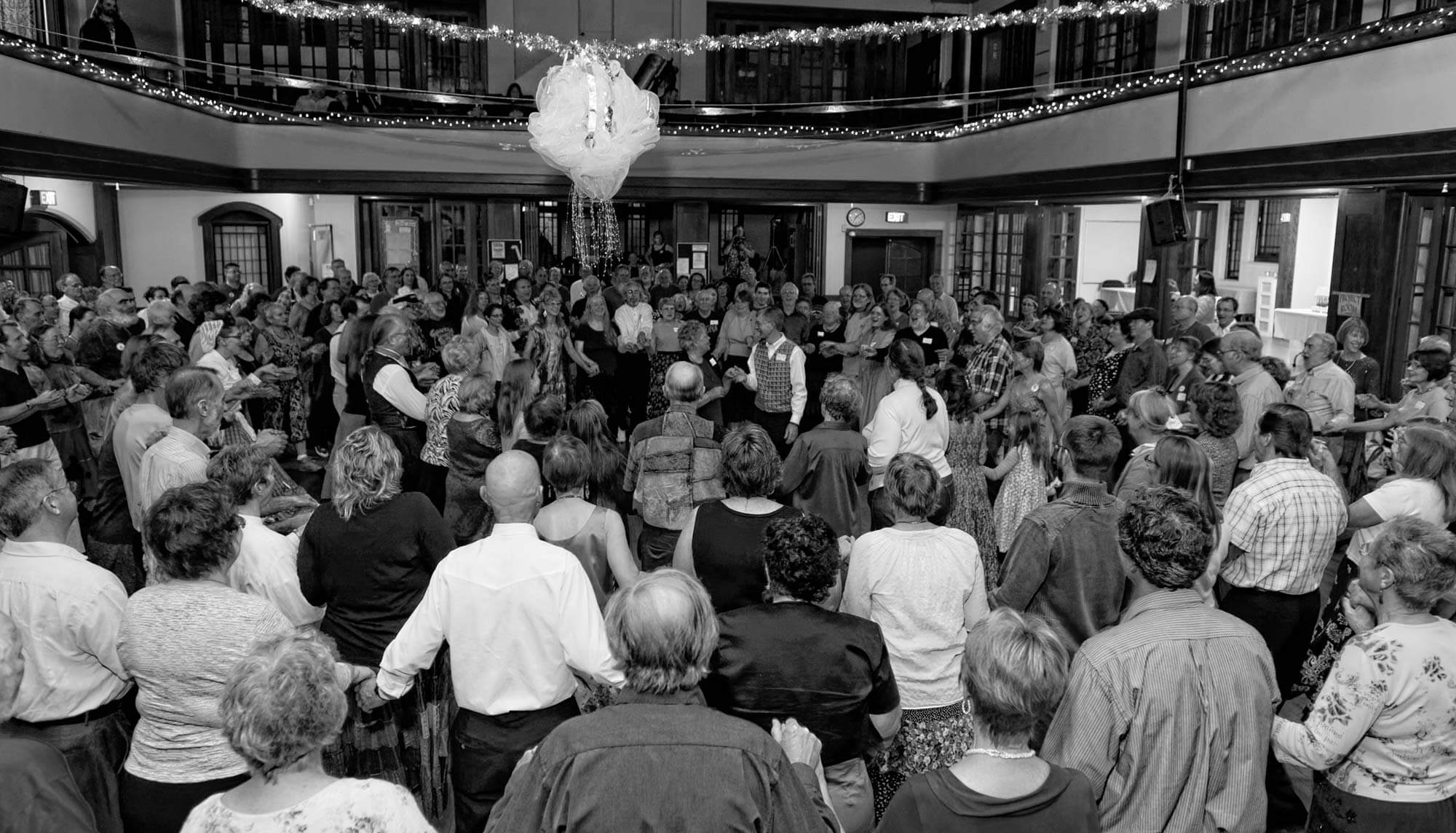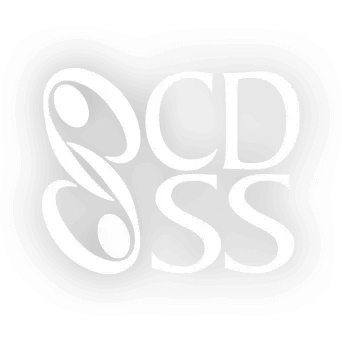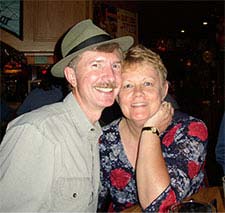“Delightfully Consumed”—How Music and Dance Took over Glen and Judi Morningstar
as told to Caroline Batson, CDSS News Editor
Glen and Judi Morningstar, an integral part of Michigan’s folk dance and music community for this past thirty-five years, are this year’s CDSS Lifetime Contribution Awardees. They have played and written music, called and written dances, taught music and dance, published music and dance books, led international music and dance exchanges, and facilitated leadership workshops—in short, they have accomplished much and inspired many (and been inspired by many, Glen and Judi will tell you). The article below is based on email correspondence with them, July-August 2013. ~ C. B.

The Beginning of Music and Dance
The multi-talented Glen and Judi Morningstar are musicians (fiddle and five-string banjo, Glen; dulcimer and piano, Judi; and bass and mandolin, both), dance band leaders (both), dance leader and organizer (Glen), tune author (Judi), and they are dancers (contra and English country dancing, eighteenth and nineteenth century historical dancing, square dancing, recreational dancing), AND they are singers (shapenote singing, folk song), dance researchers and educators. They are busy people.
Music has always been around them. Judi’s dad, Adrian “John” Emery, was a guitar player and grew up joining in the house party dances of the day; her granddad, Henry Emery, was a harmonica player; and her mom, Eva, was a stride piano player. Her other granddad, Herbert Smith, was a fiddler and played with his brothers in their family band. A lot of music was played in their home while she was growing up.
Glen’s parents were grange members and dancers, traveling the polka and grange hall circuits in Saginaw and Bay Counties, Michigan. Both sets of grandparents, the Crellers and the Morningstars, were grange members and dancers too. Glen’s parents, Glen Sr. and Ruth, met at a grange dance. Glen and his sister, Sue, joined in as youngsters. The music of his uncles, Bill and Norman Creller, guitar and mandolin, was always around the house. Uncle Bill was in a country western band (now he plays Hawaiian guitar…builds them too). Uncle George Lukezic played bass in a polka band out of Saginaw… he was “spot on,” Glen says.
Into these musical households, Glen and Judi were born, three days apart and across the street from each other, in Saginaw. Their families moved to different neighborhoods when they were very young, so they didn’t officially meet until teenagers, at neighborhood baseball games, and then at the same high school, where they started going steady. I’m not sure if they courted each other with music, but Glen used to ride his horse to meet Judi when she was visiting friends near his home. Upgrading to a car helped their relationship, they say.
The Folk Community
Music, dance and song became a larger part of their lives when they moved to Rochester, Michigan in 1975, with Glen’s transfer to Chevrolet Manufacturing R&D. There they discovered the Rochester Folk Workshop, and from there were connected to the traditional music and dance community in southeast Michigan. Paint Creek Folklore Society, led by Vince Sadovsky and John Carter, was just forming, as well as the Detroit Country Dance Society, led by Burton Schwartz and Paul Tyler. These connections broadened quickly to include rising Michigan dance communities in Ann Arbor, East Lansing, Holland, Kalamazoo, Grand Rapids, Midland and Traverse City. Glen and Judi were “on fire,” they said, learning to play additional instruments through other Paint Creek members, and honing their traditional dance skills. In 1979, encouraged by Burt Schwartz, they traveled southward to Berea Christmas Country Dance School and that REALLY got them hooked. They returned to Berea CCDS in 1981 to join the staff leaders for many enjoyable years.
Organizing—the Start of Many Things
They still have the plaque on the wall. Judi and Glen, along with music pal Tom Radcliffe, played their first gig for the Fenton Cub Scouts, in Fenton, Michigan on February 14, 1977. Judi played Appalachian dulcimer, Glen played banjo and Tom played guitar, and they sang the popular folk songs of the day. They had met Tom at PCFS, and Tom and Glen were the President and Vice President by then. Judi, too, served as both, and she and Glen each had terms as the newsletter editor. Judi, a.k.a. Aunt Lu, wrote a nearly-monthly article, “Ask Aunt Lu,” for Paint Creek Folklore Society’s newsletter, Keepin’ Tabs.
“Dear Aunt Lu… My husband recently took up the fiddle. It’s awful listening to him practice, it sounds like he’s torturing our cat and the neighbor called the ASPCA. I hate to discourage him but he’s driving me MAD! Signed, Raving & Ranting
(Aunt Lu’s response) “Dear Raving… This is a common problem among couples where only one decides to learn an instrument. Here are a few hints: Take up the fiddle with him (this will give you empathy). Buy him a mute (it works wonders for your nerves). Banish him to the basement. Encourage him to practice the same time every day and find something else to do, preferably in another city.”
Along with Tom, Glen and Judi organized the Paint Creek annual concert in 1977 as a society fundraiser…Tin Whistle Coffeehouse it was called, and it still runs today. A year later they organized the Olde Michigan Ruffwater Stringband from members of the folklore society who had either been playing for concerts and dances or were looking to be a part of that fun. With other members of Paint Creek, they organized annual music, song and dance picnics. The picnics grew into a Zing into Spring weekend (cohosted with the Detroit Folklore Society), and then an annual May Play Day, a mini-festival, with traditional music, song and dance workshops, a Maypole dance, an early evening contra and square dance, and evening concert. Paint Creek officers Gene Menton and Rick Ott worked with them to organize the first one, and it was held at Detroit Country Day School where gene was teaching. From the dancing fun at the May Play Days, came the annual Starry Night for a Ramble Contra and Square Dance, launched in 1984, organized with Jan Boonstra Pavlinak and Susan Grace Stoltz, and it, too, continues. Judi has been the annual band leader for the Paint Creek Country Dance orchestra for many years, along with JoAnn Shulte and others; they gather annually, practicing that year’s tunes for the Starry Night dance.
In the 1980s, Glen and Judi were “delightfully consumed” with organizing music, song and dance events. Ruffwater had been playing in Greenfield Village, Dearborn, as part of the offerings of the original Dulcimer Player’s Club, and Glen started leading impromptu dancing in front of Henry Ford’s family home and the Village Town Hall. They caught the eye and ear of Bob Eliason at the Village and started the monthly Lovett Hall dances in October 1981, with Glen leading the dances and Ruffwater playing the music; guest callers and groups performed as well, right up until the dance was retired in 2005. Meanwhile, Judi helped organize a women’s band called Just Friends, with Lori (Thompson) Cleland, Cecelia (Horodko) Webster, and Rosemary Kornacki, with a focus on concert presentations in the traditional and folk styles. Their reputation grew and they performed at a number of national festivals including the Philadelphia Folk Festival and the old Songs Festival.
The Danish-American Exchange and Michigan Dance Heritage
At Berea Christmas School in 1982, Dr. John Ramsay asked Glen to organize a music, song and dance exchange with a group of musicians, singers and dancers from Denmark. Away they went! Conversation began among Thy Folkedanserslaug (folk dance group) and Thy Spillemandslaug (music group) in Denmark, Paint Creek Folklore Society in Michigan, and the Frankfort Country Dancers in Kentucky. A year and a half later, twenty-five musicians, singers and dancers came from the Thy region in Denmark to stay for a week in Michigan and a week in Kentucky, presenting their music, songs and dance. They stayed in local homes, including Glen and Judi’s. “It was phenomenal!,” Glen and Judi said. The following year (1985), the Kentuckians and Michiganders traveled to Denmark to perform there, and then to Sweden with their host families. The exchanges were repeated in 1987 and 1989, opening Glen and Judi even further to the power of connection among a community’s musicians, singers and dancers.
Also in 1982, Don Coffey and “T” Auxier launched Kentucky Summer Dance School, and the Morningstars were thrilled to be a part of the staff in its early years, learning a ton of practical information about working with organizers and other musicians, callers and dancers. Four years later, at Berea Christmas School, Peter Baker, Jonathan Robie, Jean Gal and Glen, four of the Michigan dancers who were there, put their heads together— it was time to have a week or weekend of similar music, song and dance back in Michigan. The four brought the idea to the Michigan folk community, and, with their support, Michigan Dance Heritage Fall Dance Camp was launched in September 1987. Bob Dalsemer, Joel Mabus and Bud Pierce were the first headliners…“perfect.” An MDH Spring Dance Camp, called Trillium Twirl, was added by the dance community in 1992 to fulfill the large demand for this grand fun…both are weekend camps and, yes, they, too, continue to this day.
Ambassadors of Music and Dance
In 1976, Glen and Judi’s involvement with Paint Creek Folklore Society opened the door to sharing traditional music, song and dance at a variety of venues in Michigan. They enjoyed being ambassadors for the traditional arts at shopping malls, town festivals, weddings, barn dances, birthday celebrations, family reunions and, ultimately, to their community. They saw the membership of PCFS grow from twelve to seventy over five years. Their good fortune in being connected to the Henry Ford Museum and Greenfield Village for almost twenty-four years allowed them to host over two hundred contra dances in the hall that Henry Ford built specifically for traditional dance…sprung floor, crystal chandeliers, winding staircase, panorama of second floor windows, bandshell. They met many people from across North America and Europe at those dances, they said, and believe they left a positive feeling of good music and fun dancing (and a great museum) with them. The Danish Exchanges were very influential on the global perspective of traditional music, song and dance for the Michigan and Kentucky dance leaders. Participating in launching Michigan Dance Heritage’s two weekends are a real boost to keep the energy in the traditional arts at a high level for their local dance community.
One special highlight happened in 2005 when they were hired by Don and Rhonda Cardwell of Dearborn to lead the dancing for their Cape Breton Summer Dance School at the Gaelic College in St. Ann’s on Cape Breton Island. They were immersed in dance workshops and Cape Breton culture presentations each day there. In the evening Glen led dancing in Baddeck for the many styles of dance sets found around the island. The musicians…“wow!” Jerry Holland, Buddy MacMaster, Roberta Head, Bara MacNeils, Mac Morin and more. A photo of Judi playing with Buddy is priceless. Over the years, their band’s core of hammered dulcimers, has kept Glen and Judi involved with the dulcimer festivals in Michigan and the Midwest—leading instrument workshops, shapenote singing, and performing for concerts and dances. This year marks thirty-five consecutive years at the Evart Dulcimer Funfest. It’s like a big family reunion, they say: singing, dancing, concerts, workshops, jamming, eating, camping. “Yay!!” they say.
Influences
Who has inspired you musically, I asked. Bands like Bill Spence and Fennig’s All Stars, they said. The Highwoods Stringband, the Red Clay Ramblers, Hillbillies from Mars, and Bare Necessities. Instrumentalists Dudley Laufman, Randy and Rodney Miller, Laurie Andres, Shane Cook, Buddy MacMaster, Jerry Holland, Bud Pierce, Jay Round, Bob Spinner, Bob Hubbach and Les Raber.
Dancewise? Glen’s biggest inspirations came from Burt Schwartz in Michigan for his historical dance work, Bill Alkire for his fun squares out of ohio, Carole Howard from Central Michigan University for her recreational dance leadership skills, Bob Dalsemer, Tony Parkes and Ted Sannella for their contras and squares. Don Armstrong from Colorado stands out for his contras, his personal skills with people, and his promotion of our traditional dances worldwide.
And organizationally? There are so many, Glen and Judi told me. Notably, Don Hays and Debbie Jackson from Paint Creek Folklore Society, John ramsay, Joe and Patty Tarter from Berea Christmas School, Peter Baker and Jerry Hickman from Midland Folksong Society, David Baur from Trillium Twirl, Don Armstrong from the Lloyd Shaw Foundation, Don Coffey from Kentucky Summer Dance School, Svend Hamborg from Thisted, Denmark, Bob Dalsemer from everywhere good, Ted Sannella from Maine, Don Theyken the personable collaborator from Michigan, and a host of skillful organizers from AACTMAD (Ann Arbor Council for Traditional Music and Dance), the Ten Pound Fiddle (East Lansing), and the Oakland County Traditional Dance Society—“What they accomplish each year is astounding!”
Recordings
Not content to continue to lead dances, form bands, organize events, support their local dance and music societies, and perform, Glen and Judi… and I don’t know how they do it, but they do…record (both); compose, lead bands and write music books (Judi); and teach music and dance in elementary schools and homeschool communities (Glen).
Their first Ruffwater Stringband recording was in 1981—“Michigan Winter” and was a 33-1/3 LP on vinyl. DgA Productions brought their portable recording studio to Lawnridge Hall in Rochester which was the home base for Paint Creek Folklore Society. They were all in one big room together, thirteen of them, with their individual microphones. The band had practiced hard for the seventeen cuts and they recorded it all in two sessions. It mixed easy and had a great live sound. The second recording was “Michigan Spring,” produced in 1992 at Numark Studio in Utica on audio cassettes and leading edge CD, and, again, recorded in one big room with individual microphones. But this time sound “fences” were added for this recording to allow more separation of the fiddles from the dulcimers from the piano etc. It, too, mixed pretty well and still had a good live sound. They also did a number of small diameter 33-1/3 instructional records for the Lloyd Shaw Foundation from this collection of tunes. The third recording was “Michigan Summer” and was a CD in 2002. They stepped into the digital age with this recording—no longer in one big room, but rather recording the bass and rhythm tracks first, then the melody tracks separately, then the vocal tracks. It was a techie geek’s dream. Michael King Studio in Birmingham coordinated all of this recording, and it was substantially more work to mix, but turned out well. Judi has enjoyed recording two cassettes, “A Dulcimer Holiday” and “Here’s to Song” with Just Friends. Although they never made the digital crossover, they’re proud of both recordings. She also is heard in two CDs, playing piano for Bob Hubbach in “Up North, Down East,” and more recently in “Out the Buckhorn Way.”
Homeschooling
When they began leading youth dances in 1986 they were delighted that a group of about two dozen homeschoolers wanted to partake in traditional music and dance. This first group grew rapidly each year, spawning a new group of homeschoolers that then began their own annual dance. Both groups continued to grow and by 1996, attendances of one hundred eighty young people were common. A third homeschool dancing group spawned from the second group in 2002 and this group grew VERY quickly through the support of the Center family out of Royal Oak. In 2010, the Center family group moved to a new dance club facility in Madison Heights and attendances of four hundred and five hundred young people have amazed them. In the past year, Glen has received requests to lead these dances for homeschool groups in Memphis and Hart, Michigan, whose members had attended the dances in southeast Michigan. The Memphis group was organized by an energetic fifteen-year old young lady named Hannah. The first dance there saw one hundred forty teenagers attending. The expansion is underway!! Glen and Judi see the next two generations of traditional dancers, musicians and singers coming in part from these homeschool groups and the elementary schools, where Glen is leading his Dance Your Way Through History program. The Morningstars’ goal is to provide a fun, significant social experience for these young people so it becomes an instinctive part of their lives. They know that someday soon these students will be playing the music, leading the dancing, singing the songs, and organizing the events for their generation.
Over the Years
I asked Glen and Judi if their perception of traditional dance, music and song has changed over the last thirty-eight years. “YES!!,” they said. It had become increasingly clear to them, they told me, that the necessary things for a healthy lifestyle are found in traditional music, song and dance. The benefits of discipline, working together, exercise for a healthy body and mind, self-confidence, organization skills, shared respect, social skills and much more, are all to be had in the traditional music, song and dance world we live in. Now, how do we engage even more people to join us and realize these benefits, and share the fun?,” they ask each other. And us, the readers.
Retired? Ha!
Glen is retired from General Motors and Electronic Data Systems where he held many positions in Manufacturing Engineering and Information Technology. His profession has shifted to leading dance programs in schools, historical settings, for dance communities around Michigan and dance weekends across the country. He also does community volunteer work as an Advanced Master Gardener. Judi taught Appalachian and hammered dulcimers and piano for many years, and still takes the occasional student. She is a prolific tune writer and book publisher, as well as an avid reader who volunteers at Highland Township Library, and she designs and constructs her own jewelry when it’s time to relax a bit. Her immediate goal is to update the music notation in her Ruffwater Fakebook to take advantage of the crisp and clear notation in more modern music applications. Nothing has changed—they’re still busy people.
From Music and Dance, Into Music and Dance
Over the years, occasionally, not too often, but from time to time, I hear or read concerns about the lessening of the traditional music, song and dance community. But with folks like Glen and Judi Morningstar, their friends and fellow organizers in Michigan and elsewhere, strong folk communities have been and are being built. To throw oneself so enthusiastically, over so many years, with so many accomplishments to your name and still keep going, may be unusual to some, but the Morningstars of our world keep me feeling that the traditions we love are in superb hands as they pass from generation to generation.
“What are the most valuable thoughts you’ve taken away from your activities so far?” I asked at the end of the interview. “The memories of caring, dedicated, forthright people around us,” they said. “They have made our activities a true delight. What a joy to work with people in all the aspects of traditional music, song and dance, who lean forward and pour their hearts into making this community click.” I can’t say anything better about these two people myself. So, on behalf of the Country Dance and Song Society, I say thank you, Glen and Judi Morningstar—you have leaned forward and poured your hearts into our community, making it stronger and longer lasting by your gifts of music, song, dance, friendship, organization, and the ability to inspire. It’s a joy to honor you with this year’s Lifetime Contribution Award. Long may you thrive.


 Thanks to the Massachusetts Cultural Council for their generous support.
Thanks to the Massachusetts Cultural Council for their generous support.